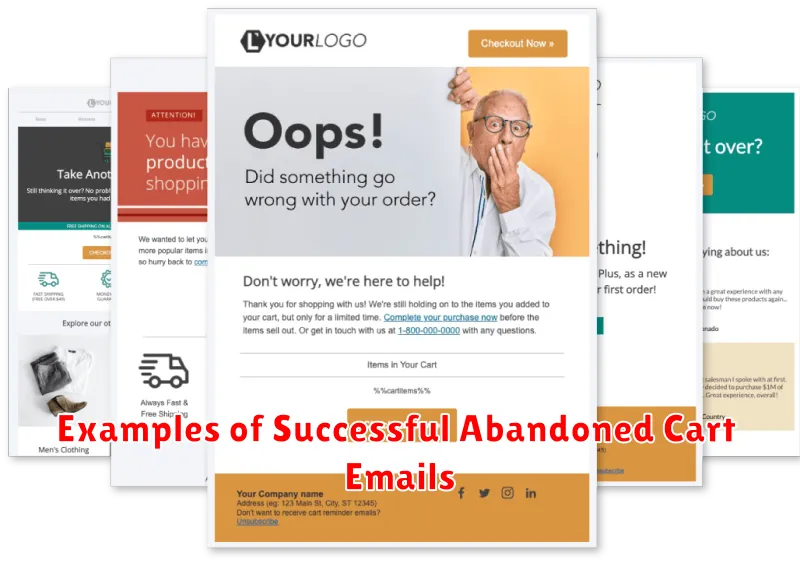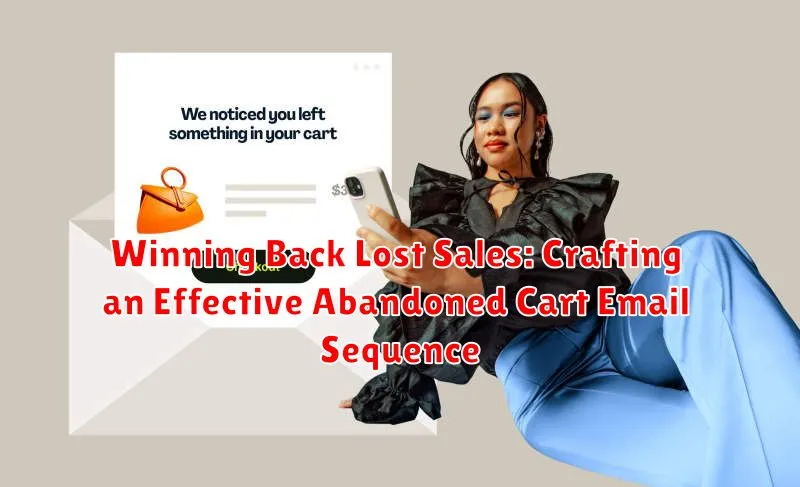Abandoned carts represent a significant challenge for e-commerce businesses. They signify potential revenue lost at the final stage of the purchasing process. Winning back these lost sales is crucial for maximizing profitability and achieving sustainable growth. Abandoned cart emails offer a highly effective strategy to re-engage customers and encourage them to complete their purchases. By crafting a strategic and compelling abandoned cart email sequence, businesses can effectively recover lost revenue and cultivate stronger customer relationships. This article will delve into the essential elements of creating a high-converting abandoned cart email sequence that rekindles customer interest and drives conversions.
An effective abandoned cart email sequence goes beyond simply reminding customers about their unfinished purchases. It requires a thoughtful approach that addresses potential reasons for cart abandonment, such as unexpected shipping costs, complex checkout processes, or simply distractions. This article will provide practical guidance on crafting a series of emails that effectively leverage persuasive messaging, personalized recommendations, and strategic incentives to recapture lost sales. Learn how to optimize your abandoned cart emails for maximum impact, from subject lines that grab attention to call-to-actions that drive conversions. Discover the key elements necessary to win back lost customers and transform abandoned carts into completed purchases.
Why Abandoned Cart Emails Are Important
Abandoned cart emails are a critical component of any successful ecommerce strategy. They represent a direct line of communication to shoppers who have demonstrated clear purchase intent but, for various reasons, stopped short of completing the transaction. Recapturing these lost sales can significantly impact your bottom line.
These emails offer a valuable opportunity to re-engage potential customers and gently nudge them back towards completing their purchase. By reminding them of the items they left behind, addressing potential concerns, and offering incentives, you can effectively convert abandoned carts into sales.
Ignoring abandoned carts means leaving money on the table. A well-crafted abandoned cart email sequence can be a highly effective tool for recovering lost revenue and boosting overall sales performance.
Understanding the Psychology of Abandoned Carts
Abandoned carts aren’t just a technical glitch; they represent a break in the customer’s purchasing journey. Understanding the underlying psychological factors can significantly improve your recovery strategy. Several key factors influence cart abandonment.
Unexpected Costs
Extra costs like shipping, taxes, or other fees revealed late in the checkout process are a primary deterrent. Price sensitivity plays a crucial role, and unexpected additions can cause customers to reconsider their purchase.
Website Issues
A complicated checkout process, technical errors, or a lack of preferred payment options can frustrate customers and lead to abandonment. Security concerns about sharing payment information can also contribute.
Simply Browsing
Not every abandoned cart represents a lost sale. Some customers are simply browsing, comparing prices, or saving items for later. They may not have been ready to purchase in the first place.
Planning Your Abandoned Cart Email Sequence
A well-planned abandoned cart email sequence is crucial for maximizing its effectiveness. Timing and frequency are key considerations. A typical sequence consists of three to four emails sent over a specific timeframe.
The first email should be sent within one hour of abandonment, serving as a gentle reminder. It can simply reiterate the items left in the cart.
The second email, sent roughly 24 hours later, can introduce an incentive like free shipping or a small discount to encourage purchase completion.
A third email, sent 48-72 hours after abandonment, might highlight customer testimonials or product benefits. This reinforces the value proposition.
A final email, if used, could offer a larger discount as a last-ditch effort. This email is often sent 3-5 days after the initial abandonment.
Crafting Compelling Email Subject Lines
The subject line is the first, and often only, impression you make. A compelling subject line is crucial for getting your abandoned cart email opened. It needs to grab attention amidst the clutter of a customer’s inbox and entice them to click.
Brevity is key. Aim for subject lines that are concise and easy to read on any device. Around 6-10 words is a good target.
Create a sense of urgency or scarcity. Phrases like “Don’t miss out,” “Items in your cart are selling fast,” or “Your cart is expiring soon” can encourage immediate action.
Personalize whenever possible. Including the customer’s name or referencing a specific item left in their cart can increase engagement.
Consider using emojis. A relevant emoji can add personality and help your email stand out, but use them sparingly.
A/B test different subject lines. Experiment with different approaches to see what resonates best with your audience and yields the highest open rates.
Writing Effective Email Copy for Abandoned Carts
Crafting compelling email copy is crucial for re-engaging customers and recovering lost sales. The goal is to gently nudge them back to complete their purchase while providing valuable information and incentives.
Start by personalizing the email. Address the customer by name and reference the specific item(s) left in their cart. This immediately connects with the customer and reminds them of their intent to purchase.
Highlight the product’s key benefits and reiterate its value proposition. Why should they choose this item? What problem does it solve? Briefly remind them of what they’re missing out on.
Create a sense of urgency. Limited-time offers, such as free shipping or a small discount, can be effective motivators. However, be mindful of not devaluing your products with excessive discounting.
Finally, ensure a clear call to action. A prominent button labeled “Return to Cart” or “Complete Your Purchase” makes it easy for the customer to continue the checkout process.
Best Practices for Abandoned Cart Email Timing
Timing is crucial for abandoned cart email effectiveness. Sending the first email too soon can feel intrusive, while waiting too long can result in lost interest. A staggered approach is generally recommended.
The first email should ideally be sent within one hour of cart abandonment. This serves as a gentle reminder and catches customers while their intent is still fresh. It often simply confirms they left items in their cart and provides a direct link back to it.
The second email can be sent 24 hours later if no conversion has occurred. This email can reiterate the value of the items left behind and potentially include customer testimonials or social proof.
A final email can be deployed after 72 hours. This email may include a limited-time incentive, such as free shipping or a small discount, to encourage the completion of the purchase. This is often the last attempt to recover the sale before the lead is considered cold.
Examples of Successful Abandoned Cart Emails

Examining successful abandoned cart emails reveals several key characteristics. These examples effectively combine compelling copy, clear calls to action, and strategic incentives to recapture lost sales.
Example 1: The Reminder
This email serves as a gentle nudge, simply reminding the customer of the items left in their cart. It often includes images of the products and a clear “Return to Cart” button. The tone is helpful, not pushy, assuming the customer simply got distracted.
Example 2: The Benefit-Driven Email
This email highlights the benefits of purchasing the items, such as free shipping, easy returns, or exclusive warranties. It focuses on the value proposition for the customer.
Example 3: The Scarcity Email
This type leverages the principle of scarcity. It might mention limited stock, a time-sensitive discount, or the popularity of the item to encourage immediate purchase.
Example 4: The Testimonial Email
This email incorporates social proof by including customer testimonials or reviews of the products in the abandoned cart. This builds trust and encourages conversion.
Using Incentives in Abandoned Cart Emails

Incentives are powerful motivators for customers to complete their purchase. Offering a discount, free shipping, or a small gift can be the deciding factor in converting an abandoned cart into a sale. However, it’s crucial to use incentives strategically.
Consider offering a tiered approach to incentives. For example, a first email might simply remind the customer of their cart. A second email could offer free shipping. A third email, sent a day or two later, might offer a percentage discount.
Free shipping is a particularly popular incentive, as unexpected shipping costs are a common reason for cart abandonment. A small percentage discount can also be effective. Consider the profit margins of your products when determining an appropriate discount amount.
Clearly communicate the terms and conditions of any incentive. For example, specify any minimum purchase requirements for free shipping or the expiration date of a discount code.

